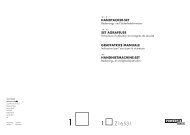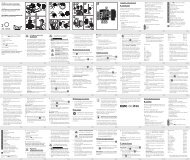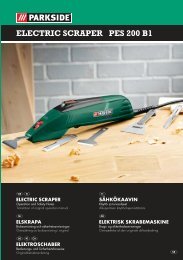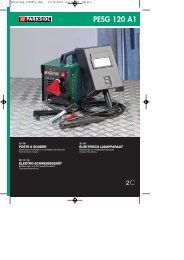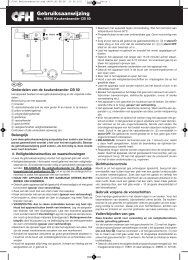FKS 2200 B1 - Lidl Service Website
FKS 2200 B1 - Lidl Service Website
FKS 2200 B1 - Lidl Service Website
You also want an ePaper? Increase the reach of your titles
YUMPU automatically turns print PDFs into web optimized ePapers that Google loves.
GB IE<br />
O<br />
P<br />
Q<br />
18<br />
Do not fell any trees when a<br />
strong or changing wind is blowing,<br />
if the danger of property<br />
damage exists or if the tree could<br />
fall on electric wires.<br />
Immediately after termination of<br />
the sawing procedure, remove the<br />
ear protection so that you can hear<br />
hooter and alarm signals.<br />
1. Removal of branches:<br />
Remove hanging branches by<br />
positioning the cut from above the<br />
branch. With removal of branches,<br />
never work higher than shoulder<br />
level.<br />
2. Escape area:<br />
Remove the undergrowth around<br />
the tree to ensure an easy<br />
escape. The escape area (1)<br />
should be around 45° either side<br />
behind the planned felling direction<br />
(2).<br />
3. Cutting notch (A):<br />
Make a felling notch in the direction<br />
in which you wish the tree to<br />
fall. Start with an upper sawing<br />
cut. Now make a<br />
sawcut below, which runs horizontally<br />
and encounters the upper<br />
sawcut exactly.<br />
The depth of cut of the notch<br />
should be approx. ¼ of the trunk<br />
diameter and the cutting angle at<br />
least 45°.<br />
Never step in front of a tree<br />
which is notched.<br />
Q<br />
R<br />
S<br />
4. Felling back cut (B):<br />
Make the back cut from the other<br />
side of the log, where you stand<br />
to the left of the log and saw with<br />
the chainsaw pulling. The back<br />
cut must run horizontally about<br />
3-5 cm above the horizontal<br />
notched cut.<br />
The back cut should be so deep<br />
that the separation distance<br />
between the back cut and the<br />
notch cutting line is at least 1/10<br />
of the trunk diameter. The part<br />
of the log not sawed through is<br />
designated as a break dimen-<br />
sion.<br />
Insert a felling wedge or a crowbar<br />
into the back cut, as soon<br />
as the depth of cut permits this,<br />
in order to prevent a jamming of<br />
the chain bar.<br />
5. If the trunk diameter is larger<br />
than the length of the chain bar,<br />
make two cuts.<br />
For safety reasons, we advise<br />
inexperienced users not to fell<br />
any logs with a rail length which<br />
is smaller than the trunk diameter.<br />
6. After carrying out of the back<br />
cut, the tree falls by itself or with<br />
the aid of the felling wedge or<br />
crowbar.<br />
As soon as the tree begins to<br />
fall, pull out the saw from the<br />
section, stop the motor, place the<br />
electric chainsaw down and leave<br />
the workplace using the withdrawal<br />
path.



